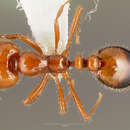en
names in breadcrumbs


Taxonomic history
Wheeler, 1915b PDF: 396 (m.); Wheeler & Wheeler, 1955c PDF: 133 (l.); Taber & Cokendolpher, 1988 PDF: 95 (k.).Junior synonym of Solenopsis geminata: Mayr, 1886d PDF: 460; Dalla Torre, 1893 PDF: 76.Revived from synonymy as subspecies of Solenopsis geminata: Wheeler, 1910a PDF: 563; Wheeler, 1915b PDF: 395.Revived status as species: Creighton, 1930b PDF: 98; Creighton, 1950a PDF: 232; Snelling, 1963 PDF: 9.Senior synonym of Solenopsis maniosa: Trager, 1991 PDF: 166.Senior synonym of Solenopsis pylades: Trager, 1991 PDF: 166.
The southern fire ant (Solenopsis xyloni), also known as the Californian fire ant or cotton ant,[1]: 89 is a stinging fire ant native to southern parts of the United States.[2][3][4] Its behaviour is similar to the red imported fire ant (S. invicta), although its sting is less painful. It has a broad and opportunistic diet, and will store seeds in its nest and eat honeydew collected from other insects.[1]: 91 [5][6]
The southern fire ant shares its range with the red imported fire ant (S. invicta), the golden fire ant (S. aurea) and S. amblychila. The southern fire ant has the widest distribution of these, occurring from the Carolinas to California, including Georgia, lowland Tennessee, Arkansas, and southern Kansas.[1]
{{cite web}}: CS1 maint: archived copy as title (link) The southern fire ant (Solenopsis xyloni), also known as the Californian fire ant or cotton ant,: 89 is a stinging fire ant native to southern parts of the United States. Its behaviour is similar to the red imported fire ant (S. invicta), although its sting is less painful. It has a broad and opportunistic diet, and will store seeds in its nest and eat honeydew collected from other insects.: 91
The southern fire ant shares its range with the red imported fire ant (S. invicta), the golden fire ant (S. aurea) and S. amblychila. The southern fire ant has the widest distribution of these, occurring from the Carolinas to California, including Georgia, lowland Tennessee, Arkansas, and southern Kansas.